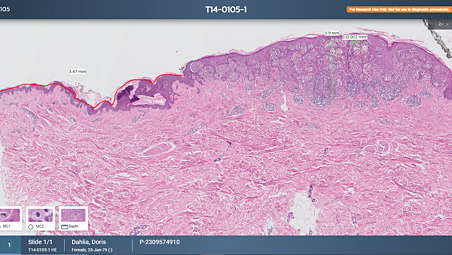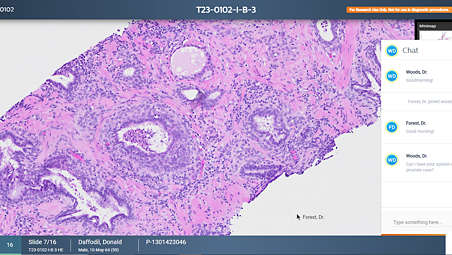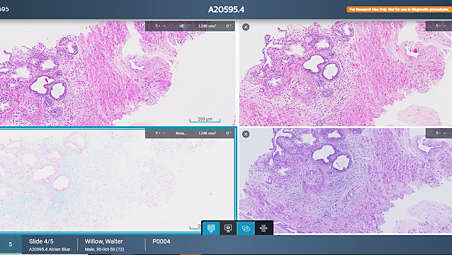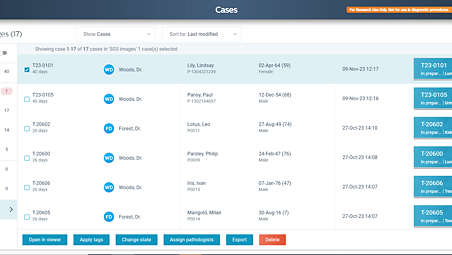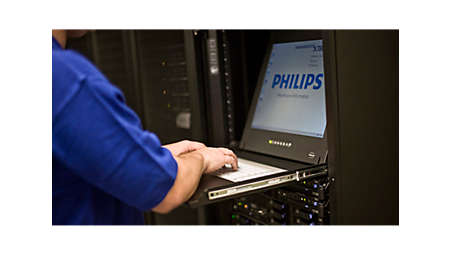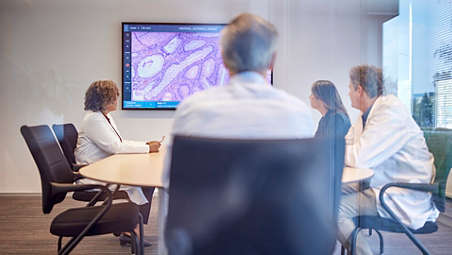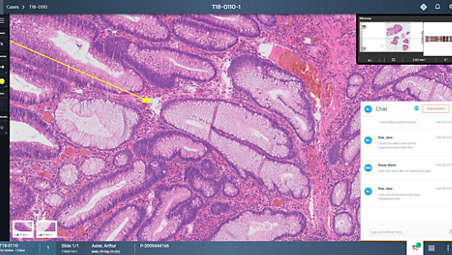Technische specificaties
- Pathology Scanner Second Generation
-
Pathology Scanner Second Generation Slide Capacity - 60
Scanning method - TDI line scanning
Focus method - Autofocus
Output format - iSyntax Philips proprietary file format with either RAW or iSyntax compression
Slide rack - Winlab LS-20/ Winlab LSM-20, Sakura 4768 20-slide basket (max. number of slides 20)
Operating temperature - 10 to 35°C
Dimensions (LxWxH in mm) doors closed - 680x800x675
Scan time (excluding handling and pre-scan per slide) - SG60 ≤ 43 seconds at 40x equivalent (15x15mm scan area)
Total scan time (including handling and pre-scan) per slide - SG60 ≤ 62 seconds at 40x equivalent (15x15mm scan area)
Average percentage of tissue detected and scanned - ≥ 99.5%
Power supply - 100-240 V AC, 50/60 Hz, 700 Watt
Magnification objective - NA of 0.75 plan Apo
Pixel size/ resolution - 0.25 μm/ pixel
Compliance to standards - EN IEC 61010-1:2010 /A1:2016, EN IEC 61010-2-101:2018, EN IEC 61326-1:2013 FCC Part 15, The IEC 6132
- The IEC 61326-2-6 (IVD), IEC 61326-1:2012 IEC 61326-2-6:2012
Barcode support - 1D code type: Code 39 with mod 43 checksum (ISO/IEC 16388:2007)
- Code 128 (ISO/IEC 15417:2007)
- 2D code type: Data Matrix ECC 200 - Code 39,
- Code 128 (ISO/IEC16022:2006) Recommended barcode type for all glass slides.
Relative humidity (no condensation) - Between 50% at 40 °C and 80% at 31 °C
Weight (kg) - 145
SG connectivity ports - Ethernet cable for 10GB (required CAT 6 Cable) / and 1GB/s network cable with RJ45
- connector (preferable CAT 6)
-
- Image Management System Review Application
-
Image Management System Review Application CPU - Intel Xeon E5-1620 v3 @ GHz or similar
RAM - 8 GB physical memory
Connectivity - 100 Mbit/s Ethernet
Video card - GPU Memory: 4GB GeForce GTX 1050 Ti or similar*
- *Updating the graphics card driver on the client computer to the latest version is recommended.
-
- Software requirements on client computer
-
Software requirements on client computer Operating system - Microsoft Windows 8, 8.1 or 10-64 bit
Browser software supporting HTML 5 standard - 100 Mbit/s Ethernet
Connectivity - Chrome (recommended), Internet Explorer***
- *** Chrome is required for the feature Use my computer for image processing.
Video card - GPU Memory: 4GB
- GeForce GTX 1050 Ti or similar*
Other software - *Updating the graphics card driver on the client computer to the latest version is recommended.
-
- Image Management System Application Server and Storage Software
-
Image Management System Application Server and Storage Software CPU - Dual socket Intel 6-core @ 2.3GHz
RAM - 32GB
Storage - Protection against a single disk failure, e.g. RAID configuration or data replication.
- For usage with 5 scanners or more: Flash Disks
-
- Pathology Scanner Second Generation
-
Pathology Scanner Second Generation Slide Capacity - 60
Scanning method - TDI line scanning
-
- Image Management System Review Application
-
Image Management System Review Application CPU - Intel Xeon E5-1620 v3 @ GHz or similar
RAM - 8 GB physical memory
-
- Pathology Scanner Second Generation
-
Pathology Scanner Second Generation Slide Capacity - 60
Scanning method - TDI line scanning
Focus method - Autofocus
Output format - iSyntax Philips proprietary file format with either RAW or iSyntax compression
Slide rack - Winlab LS-20/ Winlab LSM-20, Sakura 4768 20-slide basket (max. number of slides 20)
Operating temperature - 10 to 35°C
Dimensions (LxWxH in mm) doors closed - 680x800x675
Scan time (excluding handling and pre-scan per slide) - SG60 ≤ 43 seconds at 40x equivalent (15x15mm scan area)
Total scan time (including handling and pre-scan) per slide - SG60 ≤ 62 seconds at 40x equivalent (15x15mm scan area)
Average percentage of tissue detected and scanned - ≥ 99.5%
Power supply - 100-240 V AC, 50/60 Hz, 700 Watt
Magnification objective - NA of 0.75 plan Apo
Pixel size/ resolution - 0.25 μm/ pixel
Compliance to standards - EN IEC 61010-1:2010 /A1:2016, EN IEC 61010-2-101:2018, EN IEC 61326-1:2013 FCC Part 15, The IEC 6132
- The IEC 61326-2-6 (IVD), IEC 61326-1:2012 IEC 61326-2-6:2012
Barcode support - 1D code type: Code 39 with mod 43 checksum (ISO/IEC 16388:2007)
- Code 128 (ISO/IEC 15417:2007)
- 2D code type: Data Matrix ECC 200 - Code 39,
- Code 128 (ISO/IEC16022:2006) Recommended barcode type for all glass slides.
Relative humidity (no condensation) - Between 50% at 40 °C and 80% at 31 °C
Weight (kg) - 145
SG connectivity ports - Ethernet cable for 10GB (required CAT 6 Cable) / and 1GB/s network cable with RJ45
- connector (preferable CAT 6)
-
- Image Management System Review Application
-
Image Management System Review Application CPU - Intel Xeon E5-1620 v3 @ GHz or similar
RAM - 8 GB physical memory
Connectivity - 100 Mbit/s Ethernet
Video card - GPU Memory: 4GB GeForce GTX 1050 Ti or similar*
- *Updating the graphics card driver on the client computer to the latest version is recommended.
-
- Software requirements on client computer
-
Software requirements on client computer Operating system - Microsoft Windows 8, 8.1 or 10-64 bit
Browser software supporting HTML 5 standard - 100 Mbit/s Ethernet
Connectivity - Chrome (recommended), Internet Explorer***
- *** Chrome is required for the feature Use my computer for image processing.
Video card - GPU Memory: 4GB
- GeForce GTX 1050 Ti or similar*
Other software - *Updating the graphics card driver on the client computer to the latest version is recommended.
-
- Image Management System Application Server and Storage Software
-
Image Management System Application Server and Storage Software CPU - Dual socket Intel 6-core @ 2.3GHz
RAM - 32GB
Storage - Protection against a single disk failure, e.g. RAID configuration or data replication.
- For usage with 5 scanners or more: Flash Disks
-
- *It has market clearance in EEA (European Economic Area), United Kingdom, Ireland and Singapore. Specific conditions apply to the USA market.
- Philips IntelliSite Pathology Solution (PIPS) is in conformance with Regulation (EU) 201 7/746 of the European Parliament and of the Council of 5 April 2017 on In Vitro Diagnostics (IVDR).

